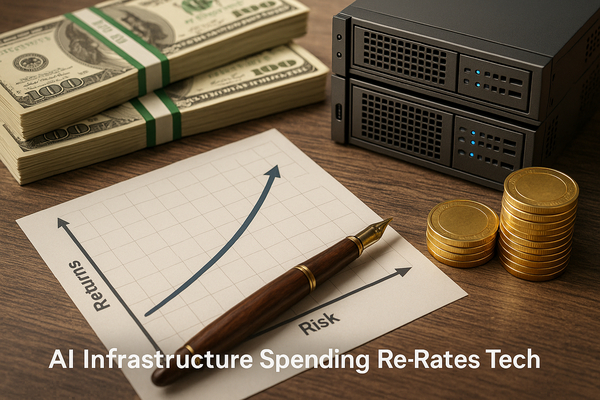
Executive summary
The Information Technology sector has moved from expectation to execution on large-scale artificial intelligence (AI) investments. Two themes dominate: hyperscaler and partner capital committed to data-center buildouts, and surging demand for memory and system-level components that feed AI compute. The result: fast earnings upgrades for select hardware suppliers, strong price action for memory names, and renewed attention to cloud and software firms that monetize AI. Investors should balance exposure to the hardware winners driving current revenue upgrades with select software franchises that convert AI adoption into recurring revenue—while monitoring valuation compression risk after several multi-hundred-billion-dollar commitments.
Capital commitments are reshaping demand dynamics
The scale of announced projects is rare. Nvidia’s agreement to invest up to $100 billion with OpenAI to support AI data-center expansion and the OpenAI–Oracle–SoftBank “Stargate” program—now planning five additional data centers and raising the project to nearly 7 gigawatts with >$400 billion of investment—are primary demand drivers. Oracle’s role in Stargate has been accompanied by commentary that the company could capture a $300 billion five‑year cloud opportunity.
Hyperscaler activity is broader: Microsoft is committing $7 billion to Wisconsin AI data-centers and other firms are building multi‑gigawatt campuses. These capital flows are pushing component and memory demand forward and are a proximate cause for recent earnings beats among suppliers.
Memory and semiconductors: immediate beneficiaries
Micron (MU) exemplifies the earnings upside. Fiscal Q4 revenue reached $11.32 billion with adjusted EPS of $3.03—beating consensus—and management forecasted sequential revenue growth of roughly $1.2 billion and gross margins above 50%. Micron’s results produced outsized share-price moves: the stock jumped after the release and was the subject of a reiterated $200 price target from Rosenblatt.
Semiconductor ecosystem moves also matter. Nvidia’s share price hit record levels (intraday highs near $183.61) before some short-term giveback; market commentary flagged both the upside (e.g., UBS estimating enormous revenue potential tied to Nvidia–OpenAI collaboration) and potential circular financing risks tied to inter-company investments. Intel’s announcement of a strategic relationship with Nvidia (reports of a $5 billion Nvidia stake in Intel) underscores how partnerships are shifting product roadmaps and capacity investments.
Equipment suppliers are being repriced: Applied Materials (AMAT) and Lam Research (LRCX) received differentiated analyst views (KeyBanc prefers AMAT as a cheaper entry), while ASMI trimmed near-term revenue expectations—evidence that equipment demand is strong but not uniform across suppliers.
Software and cloud: recurring revenue meets AI monetization
Software firms tied to data, orchestration, and AI analytics are capturing the higher-margin patterns of adoption. Snowflake (SNOW) expanded partnerships and is central to an Open Semantic Interchange (OSI) initiative; its momentum in cloud analytics is being framed as a growth thesis enhancement. Salesforce (CRM) reported AI and Data Cloud ARR rising to $1.2 billion in Q2, signaling stronger monetization of AI features into subscription revenue.
Palantir (PLTR) continues to trade at elevated multiples following defense and enterprise deals (e.g., BofA lifting its price target to $215), while Snowflake and ServiceNow partners are forming standards to accelerate enterprise AI — all pointing to an AI software wave that is increasingly subscription-driven rather than one-off professional services.
Market reaction and valuation risks
The market has rewarded names exposed to AI hardware and cloud with outsized multiples, creating near-term volatility. The Nasdaq Composite swung intraday, with one report showing a drop of 0.9% to 22,573.47 on a day when AI-driven names initially pushed indices to fresh highs. Commentators—including Federal Reserve Chair Jerome Powell—have warned that equities are “highly valued,” and some strategists caution that the AI trade could overheat.
Valuation concentration is visible. Nvidia’s share moves (record closes then pullbacks from the highs) and critical analyst notes on “circular” financing highlight a scenario where progress in AI spend is positive for revenue but raises questions about the sustainability of multiple expansion. Several firms, including Damodaran’s commentary on Microsoft and others, emphasize that proof of durable ROI from AI investments is not yet fully visible in margins across the hyperscalers.
Cross-cutting risks investors should track
- Execution and supply: Companies such as Micron are signaling demand that exceeds typical cycles; watch guidance execution and inventory changes. Micron’s sequential guidance implied a large near-term uplift of roughly $1.2 billion.
- Concentration risk: A small set of names—Nvidia, Micron, Oracle, Microsoft—account for a disproportionate share of AI-related market moves.
- Regulatory and geopolitical: Trade and national security actions (referenced in commentary about tariffs and U.S. stakes in mining and manufacturing) can affect supply chains and capital flows.
- Macroeconomic sensitivity: Powell’s comments and Fed rate policy could change the discount rates applied to long-duration growth profits that many AI names trade at today.
Where active investors may consider positioning
Portfolio tilts should be tactical and data-driven. Possible allocations and trade ideas for informed investors:
- Memory exposure (selective): Memory providers with clear AI-data-center revenue—Micron being the clearest example—benefit from current demand and raised guidance. Micron’s Q4 beat and guidance imply near-term upside; traders may prefer exposure via calls or selective-size positions given the stock’s recent run.
- Systems and accelerators: Semiconductor companies supplying AI chips and interconnect (Nvidia, AMD, Arista Networks for cloud networking) are tied directly to the buildout. Expect volatility; use disciplined risk limits.
- Cloud and enterprise software: Firms converting AI features into recurring ARR—Salesforce (AI & Data Cloud ARR at $1.2B), Snowflake (OSI participation), Palantir (defense wins)—offer more stable cash conversion potential, but watch re-rating risk if growth expectations slip.
- Selective infrastructure plays: Oracle and Microsoft are beneficiaries of Stargate and hyperscaler capex—Microsoft’s $7B commitment and Oracle’s cloud role suggest hardware-adjacent revenue for database and IaaS providers.
Data gaps and what to watch next
The dataset reviewed contains strong corporate announcements and quarterly outcomes but limited granular valuation metrics (e.g., up-to-date sector-wide P/E medians, forward FCF yields). Investors should request the latest blended forward P/E and free-cash-flow yield figures to quantify re-rating risk. Key upcoming data points to monitor include quarterly capex plans from hyperscalers, Micron’s next-quarter guidance relative to consensus, and algebraic proof points on AI monetization (ARR expansion, gross-margin improvement) at software vendors.
Conclusion
Capital-intensive AI infrastructure commitments have created a two-speed market: hardware and memory vendors are seeing immediate demand and earnings upgrades, while software and cloud firms must demonstrate durable monetization to justify higher multiples. For active investors and professionals, the imperative is to pair exposure to the direct beneficiaries of AI capex with disciplined risk controls tied to valuations and execution metrics. Watch sequential revenue guidance (Micron’s $1.2B uplift), hyperscaler capex announcements (Oracle/Stargate, Nvidia–OpenAI $100B), and AI-sourced ARR growth (Salesforce’s $1.2B) to time entries and size positions prudently.
Note: This article synthesizes recent company reports and market commentary from September 2025. Some valuation details (sector median P/E, up-to-the-minute market caps) were not available in the source dataset and should be confirmed before executing trades.












